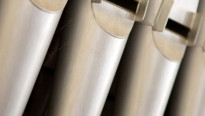
With its Johannus Digital Room Correction (JDRC) software, Johannus has made another breakthrough in optimizing the sound reproduction of new home organs, based on the newest DS Core technology.
Specially developed software ensures that the sound of each individual organ can be adjusted to suit the room in which it is located.
Those who play Johannus organs are undoubtedly familiar with their phenomenal sound quality. According to renowned organ connoisseurs, no other digital organ builder sets the standard as high as Johannus for the authentic sound reproduction of original pipe organs. Despite this, the research and development department at Johannus has managed to further refine the sound quality of its new line of home organs.
Software
On closer examination, it turns out that this refinement is not new, according to audio specialist Bertus Lap. ‘In the factory, private organs were already tuned in such a manner that they deliver the best sound quality in most living rooms. In addition, we gave the customer the opportunity to further refine this tuning through the use of our voicing software, among other things. The breakthrough is that we have incorporated this nuanced quality into the software that we have developed: Johannus Digital Room Correction. This system makes it possible to optimally adjust the sound on location, to suit the space in which the organ is located.’
As Lap explains, sound behaves differently in each space. ‘The preferred frequencies in a large living room differ from those in a small living room. Certain tones accumulate and sound louder, while other tones ‘lift’ each other, making them softer. Because each space colours sound in its own way, you need advanced technology to help you reproduce each tone correctly according to your requirements.’
There is also another challenge: the speaker. The loudspeaker also has an important effect on the resonance of the sound, explains the audio specialist. ‘Each speaker has its own character. The loudspeaker you use therefore has an effect on the ultimate sound reproduction.’
Greatly simplified
Now that the technical components required for refining the sound are incorporated into software, dealers can optimise the settings on location. ‘We have automated the process to the extent that it is greatly simplified. Our very specific knowledge in the field of audio is now built into an intuitive programme. It consists of a microphone, measurement equipment and software. Using the equipment and the microphone, you measure the space and the effect of the space on each sound channel individually, and then you use the software to carry out the correction.’
This session can be undertaken by dealers on location in the homes of their customers. Lap explains briefly how it works. ‘We place the microphone on the organ bench, exactly where the player sits. In this way, we imitate the ears of the organist, as it were. Then the software plays a signal containing all of the frequencies. You have to imagine this as a rising tone, going from inaudibly low to inaudibly high, with all of the audible tones in between, naturally. We call this signal a “sweep”. In the meantime, the microphone measures the loudness of each part of the signal. This informs the software very precisely about how the space responds to each individual frequency. The measurement results in each space vary uniquely from the quality standards we set for sound reproduction. The software knows the standards and calculates the number of filters required to meet the standards in detail. For each frequency, it determines whether it should sound louder or softer, until the sound reproduction displays a straight, stable line and all of the tones are reproduced as faithfully as possible. After the filters have been calculated, the software produces the suggested adjustments. The dealer can send these suggested adjustments to the organ in order to programme the sound reproduction. This process is carried out separately for each individual sound channel.’
Measurement of volume
Once the sound has been fine-tuned, a volume measurement is carried out for each speaker. ‘Sometimes, an organ is placed closer to a wall on one side than on the other. The position of the speakers with respect to the space can cause colouring of the sound. Because we can measure the volumes with our new software, we’ve also allowed dealers access to volume refinement.’
The Johannus LiVE organs delivered up until now are already tuned according to these high quality standards, emphasises Lap. ‘Previously, our specialists adjusted these settings during the preparation for delivery. Thanks to advancing knowledge and innovation, we’ve been able to make this technology more broadly accessible.’